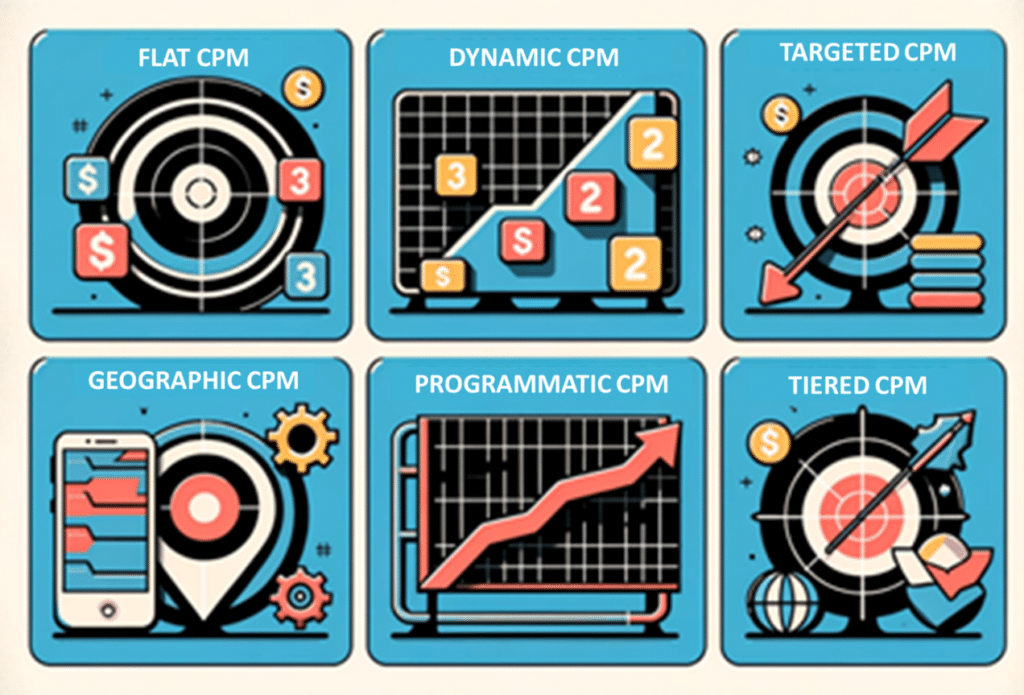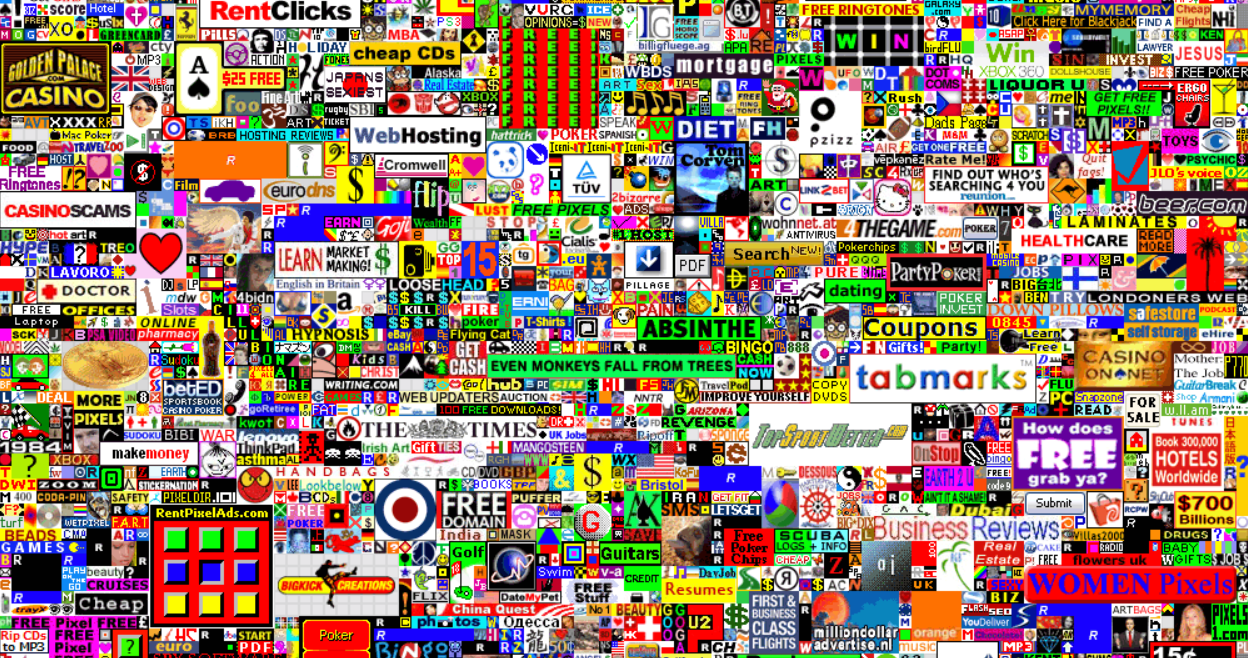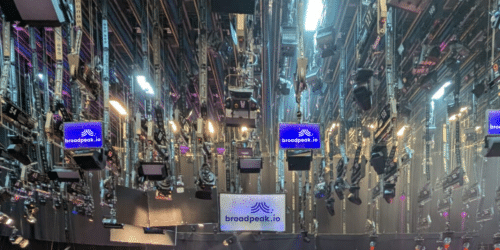One critical metric that stands out in the AdTech world is Cost Per Mille (CPM1), an acronym deeply rooted in advertising history and universally used in the Streaming / CTV landscape as a base for any business model.
This blog post explains CPM and how it applies to the TV industry, traces its historical roots, and explores beyond its existence.
First things first: What is CPM in streaming and CTV?
CPM, or Cost Per Mille, describes the cost an advertiser pays for a thousand impressions (views) of their advertisement. In the context of Streaming and CTV, which encompasses internet-enabled televisions and streaming devices, CPM becomes a crucial metric for advertisers aiming to gauge the effectiveness and cost-efficiency of their campaigns on these platforms.
It represents the number of times a video player has displayed an advertisement.

The Historical Roots of CPM
But let us start from the beginning. The term “CPM” originated in traditional print media advertising, a concept that transitioned into radio and television. It was a way to standardize the cost of ads across different mediums, regardless of their audience size. With the advent of digital media, CPM found new ground, adapting to the needs of online advertisers, and eventually becoming a staple in CTV advertising.
The term “Cost Per Mille” (CPM) is often thought to have roots in French, given the prominence of French in the history of advertising and media (but it is probably more coming from the Latin word, not the French one, but as a French myself, I can dream, right ?). Indeed, “mille” means “thousand”.

Its usage in advertising started probably in the mid-20th century. Its exact origin date is difficult to pinpoint. Still, it emerged as a standard advertising metric, particularly in the context of traditional media, such as print and television, before the advent of the digital age.
CPM became a crucial advertising metric to standardize the costs of ads across different media platforms. It provided a way to compare the cost-effectiveness of other advertising mediums by quantifying how much an advertiser would pay for one thousand views of their ad.
A quick anecdote on CPM
Before getting too serious, I was looking at stories around the CPM. I came across one of the CPM model’s most creative and unconventional uses.

“The Million Dollar Homepage,” created in 2005 by British student Alex Tew, is a prime example of the creative use of the Cost Per Thousand Impressions (CPM) model in advertising. Designed to fund Tew’s university education, the website offered a million pixels for sale at $1 each, in blocks of one hundred pixels, for advertisers to display their ads or logos. This unique approach effectively priced the ad space at $1,000 per 10,000 pixels, mirroring the CPM model’s rate of $100 per 1,000 impressions.
In my mind, this story underscores not just the adaptability of the CPM model across different contexts but also how innovative strategies can transform standard advertising practices.
CPM in Streaming and CTV
Money flow
It is essential first to understand who is paying what to whom. The following diagram shows how an advertiser passes by many stops before paying a publisher.

The essential terms to know here are DSP and SSP:
- A DSP (Demand Side Platform) is a system that enables advertisers and agencies to automate the purchase of digital ad inventory across multiple sources, using sophisticated algorithms to target specific audiences and optimize ad spending.
- An SSP (Supply Side Platform) is a technology platform that allows digital media owners, such as publishers and broadcasters, to manage, sell, and optimize their advertising space inventory to multiple buyers efficiently.

Before the CPM, the GRP
Gross Rating Point (GRP) is the traditional and standard measure used in the broadcasting industry to assess the size of an advertising campaign’s reach. It quantifies the impact of a particular advertisement or campaign by combining two metrics: reach and frequency.
- Reach refers to the percentage of the target audience exposed to the ad.
- Frequency is the average number of times those within the target audience see the advertisement.
The GRP is calculated by multiplying the reach (expressed as a percentage of the target audience) by frequency.
A GRP of 100, for example, means that the average person in the target audience has been exposed to the advertising campaign once or that 1% of the target audience has seen it a hundred times.
This metric has been crucial for advertisers and broadcasters because it provides a simple yet effective way to gauge the extent of an advertisement’s exposure in each market on TV. Most TV markets are still being sold by cGRP (cost per Gross Rating Point).
How is GRP slowly getting replaced by CPM in the Streaming industry?
We notice that players in the streaming industry are talking less about GRP and more about CPM; why is that?
Well, it is a matter of definition and focus. As we mentioned, GRP measures the reach and frequency of an advertising campaign, concentrating on the breadth of the exposure. Again, it tells advertisers how many people in their target audience might have seen their ad and how often.
CPM, on the other hand, focuses on the cost-efficiency of reaching a thousand viewers or readers.
That being said, the shift towards streaming in the TV industry is the reason for the increasing preference for CPM. Digital platforms offer precise tracking and analytics, allowing advertisers to measure the exact number of impressions an ad receives. This precision makes CPM a more suitable and transparent metric for digital advertising.
Nevertheless, the unification of the data points between GRP and CPM is a hot topic, called Total Video. We may come back to this in a blog post at some point.
Basic types of CPM in CTV
There are many ways to look at CPM. Here, you will find the most popular from the buyer’s side.

- Flat CPM: A single rate for a thousand impressions, regardless of audience segmentation or engagement levels.
- Dynamic CPM: Varies based on targeted demographics, viewer engagement, and ad placement relevance.
- Targeted CPM: With the advanced audience targeting capabilities of CTV and streaming platforms, advertisers often pay a premium for more precisely targeted ad impressions. This CPM rate is higher as it promises more relevant audience reach based on demographics, interests, viewing habits, and other data points.
- Programmatic CPM: Involves real-time automated bidding for ad space, where CPM rates fluctuate based on demand and audience desirability.
- Geographic CPM: Geographic targeting can influence CPM rates, with costs varying based on the audience’s location. For instance, ads targeted at viewers in high-income regions or major metropolitan areas might have higher CPM rates.
- Tiered CPM: Some CTV platforms offer tiered CPM rates based on the quality or popularity of content. Like popular shows or exclusive releases, premium content often commands higher CPM rates due to higher viewer engagement and demand.
Calculating CPM in OTT (Streaming/CTV)
To calculate CPM in OTT (Over-the-top), divide the total cost of the ad campaign by the total number of impressions, then multiply by 1,000. This calculation helps advertisers in budget allocation and campaign optimization.
The Difference between Inserted Ads and Printed Ads
In broadpeak.io, we deliver ads with our Dynamic Ad Insertion application (SSAI or Video Stitcher). We apply a CPM based on Ads Inserted in our customers’ content or, sometimes, for our enterprise customers based on the number of Ads Printed.
In the Server-Side Ad Insertion (SSAI) context, understanding the difference between ad insertion’ and ad impression’ is crucial, as they represent distinct stages and aspects of the advertising process.
Ad Insertion in SSAI
Ad insertion, particularly in SSAI, refers to integrating advertisements into content. What happens after the insertion does not matter; you count on the video stitcher when you insert and how many times you do it. Whether viewers watch the ads or CDN caches them does not matter.
Ad Impression in SSAI
An ad impression, on the other hand, is a measure of how many times the ad is viewed. In SSAI, an impression is counted when:
- Ad Viewing: The ad inserted into the content is displayed to the viewer. This means the viewer has reached the point in the content where the ad is played on the viewer’s player/screen.
- Tracking Impressions: The server tracks each time an ad is displayed, counting it as an impression. This is crucial for advertisers as it helps measure the effectiveness of their ad campaign.
- Billing and Metrics: Ad impressions are a vital metric for billing and analyzing the performance of ad campaigns. They help advertisers understand how many viewers have potentially seen their ad.
In any case, broadpeak.io fires beacons to the ad servers via Server-Side Ad Tracking or Client-Side Ad Tracking, so we always keep track of the impressions, whether you are charged and billed with us on this metric or not. For CSAT, those beacons can be compliant with IAB Open Measurement certification, which gives additional confidence and trust to the reported metrics.
Finally, in summary, ad insertion via SSAI is about counting how many times you integrate ads into streaming content, while ad impressions are about counting and measuring the visibility and reach of these ads to the audience.
CPM vs. Other Advertising Metrics which are not (yet) relevant in the streaming industry
While CPM is critical in the Ad Industry, it is one of many metrics. Cost Per Click (CPC) and Cost Per Acquisition (CPA) also play significant roles. CPM is about the reach, CPC focuses on the number of clicks, and CPA revolves around conversions. Savvy advertisers often balance these metrics for a comprehensive campaign strategy.
Cost Per Click (CPC)
- Definition: Cost Per Click is a metric used to know the cost an advertiser pays each time a user clicks on their advertisement. It is a way to quantify the immediate response or interaction an ad receives from its audience.
- Usage in Campaigns: CPC is commonly used in advertising platforms, like search engine advertising (Google Ads, for instance), social media advertising (Facebook, Twitter, etc.), and other online ad networks. It is particularly relevant in campaigns that drive website or landing page traffic.
- Benefits: The primary benefit of CPC is that it allows advertisers to pay only for the engagement they receive, making it a cost-effective approach for driving website traffic. It is also a straightforward metric to track and optimize, making it popular for many online campaigns.
- Optimization: Advertisers often optimize their campaigns for CPC by focusing on ad relevance, keyword selection (in search advertising), and compelling ad creative to encourage clicks.
Cost Per Acquisition (CPA)
- Definition: Cost Per Acquisition, also known as Cost Per Action, is a metric that measures the total cost of an advertisement relative to the number of conversions or acquisitions it generates. A conversion could be a sale, a signup, a form submission, or any other defined action that aligns with the advertiser’s goals.
- Usage in Campaigns: CPA is crucial in campaigns where the end goal is not just a click but a specific action, such as making a purchase, subscribing to a service, or completing a registration form.
- Benefits: CPA is highly valued for its direct correlation with the advertiser’s ultimate objective, sales, or leads. It provides a clear picture of an ad campaign’s return on investment (ROI), as it relates directly to the actions contributing to the business’s bottom line.
- Optimization: Advertisers focus on optimizing the entire conversion funnel for CPA. It includes targeting the right audience, creating high-converting landing pages, and ensuring a seamless user journey from ad click to conversion. They may also improve performance using A/B testing and optimization of conversion rate.
Comparison and Complementarity
- CPC vs. CPA: While CPC focuses on the initial click or engagement with the ad, CPA goes a step further to measure the effectiveness of that engagement in driving a specific action. CPC is about getting attention; CPA is about converting that attention into a desired outcome.
- Choosing Between Them: The choice between CPC and CPA depends on the campaign objectives. For brand awareness or traffic generation, CPC might be more relevant. CPA becomes more critical for direct sales, leads, or specific actions.
- Using Both Together: Advertisers often use both metrics to get a complete picture of their campaign’s performance. CPC can guide adjustments for initial engagement, and CPA can help optimize for the end goal.
In summary, CPC and CPA are essential metrics in digital advertising, each serving a distinct purpose. CPC is necessary for measuring and optimizing engagement and traffic, while CPA is crucial for understanding and improving the effectiveness of ads in driving conversions.

Concept of eCPM
You can apply the CPC and CPA concepts to the CPM methodology as soon as you understand them. Consequently, actors in the industry created the eCPM2 (effective cost per mille).
Unlike the traditional CPM, which calculates the cost per thousand ad impressions, eCPM considers the actual revenue generated per thousand impressions. This metric is particularly valuable in environments where advertising costs are not solely based on impressions but on cost-per-click (CPC) or cost-per-acquisition (CPA) models.
eCPM is calculated by dividing the earnings from an ad campaign by the total number of impressions, then multiplying by 1,000.
This calculation gives advertisers and publishers a more comprehensive view of their ad campaign’s efficiency, enabling them to compare the effectiveness of different advertising strategies on an apples-to-apples basis.
This methodology is what is called the Ad Performance model. That model emphasizes paying only for clicks that hold real value instead of traditional ad impressions. This approach operates under the principle of ‘no loss, but no guaranteed gain,’ making it a particularly suitable model for small businesses. These businesses often need more predefined advertising budgets and dedicated purchasing departments, making traditional ad-buying methods less feasible.
In this context, Google’s role in advertising is analogous to what digital technology has been to photography. Just as digital photography eliminated the need for film development, Google’s advertising model obviates the need to negotiate ad budgets. It democratizes the advertising process, allowing even small players to participate effectively without the conventional entry barriers, like hefty upfront investments and complex budget negotiations. This click-focused model provides a more accessible and performance-oriented advertising avenue, aligning costs directly with tangible results.
Ad Performance in the streaming industry?
Unfortunately, eCPM, CPC, and CPA have been massively overlooked in the streaming industry because television, and by extension streaming, has traditionally emphasized audience advertising over performance advertising, shaping how brands interact with consumers through these mediums. CPC and CPA asked for a feedback loop, but TV never focused on giving them one.
Logically, advertising was about reaching as broad an audience as possible in the TV era, focusing on brand exposure and audience engagement rather than immediate, measurable outcomes like clicks or sales, typical of performance advertising. This approach capitalizes on TV’s broad reach to build brand awareness and loyalty over time. As streaming platforms evolved, they adopted this model, leveraging their capacity for detailed viewer data to offer even more nuanced audience targeting.
While performance advertising, emphasizing direct responses and measurable results, dominates digital platforms like search engines and social media, TV and streaming have remained bastions of audience advertising.
The situation is doomed to change; broadpeak.io will bring Performance Advertising to the main screen ? and get millions more advertisers to the streaming industry: please watch this sneak peek of our Click2 product demo.
Exploring Advanced Ad Impressions in CTV: MAI, Backfill, and Mirrored Impressions
Various advanced types of CPM are suitable to understand in the Streaming world.
- A Monetizable Ad Impression (MAI) is an advertisement provided by a Supply-Side Platform (SSP), specifically targeted at a streaming session, inserted, and tracked by Server-Side Ad Insertion (SSAI). This type of ad is significant as it is directly monetizable by the SSP provider, making it an asset in digital advertising strategies.
- Conversely, a Backfill Impression, also supplied by the SSP and tracked by SSAI, differs as it is not monetizable by the SSP provider. These impressions are typically used to fill unsold ad inventory and ensure a consistent viewer experience, but they do not directly contribute to revenue.
- Lastly, the Mirrored Impression is a unique category where the ad, provided by the SSP and tracked by SSAI, mirrors the advertisement in the original linear channel. Unlike targeted ads in MAI, these are not specific to the streaming session but are replicated from the traditional broadcast. This approach maintains uniformity between broadcast and streaming platforms but may need more targeted effectiveness of MAI.
Understanding these distinctions is crucial for advertisers and publishers in optimizing their strategies and maximizing the efficiency and profitability of their ad campaigns in the Connected TV landscape.
One last frequent practice impacting the CPM price in CTV: the inventory sharing
What is inventory sharing in CTV?
- Definition: Inventory sharing in CTV refers to the practice where multiple parties, such as content providers, streaming platforms, and distributors, share the ad inventory available within a particular content or channel. This inventory consists of ad slots that can be sold to advertisers.
- How It Works: A streaming service might agree with content creators or distributors to split the available ad slots in a typical scenario. For example, some ad slots might be allocated to the streaming service during a show, while others are reserved for the content provider or distributor.
- Dynamic Ad Insertion: With technologies like broadpeak.io Server-Side Ad Insertion (SSAI), ads can be dynamically inserted into content, making inventory sharing more feasible and efficient. Each party can insert different ads into their allocated slots for specific audiences.
What are the impacts on CPM Costs?
- Increased Inventory Supply: Inventory sharing effectively raises the total ad inventory in the CTV ecosystem. With more ad slots available, there’s potential for a change in the supply-demand dynamics, which can impact CPM rates.
- Competitive Pricing: More inventories can lead to competitive pricing. If the demand does not keep pace with the increased supply, it might lead to lower CPM rates. Conversely, if the shared inventory reaches highly engaged or premium audiences, it could command higher CPMs.
- Targeting and Relevance: Inventory sharing allows different parties to target ads more precisely. If advertisers perceive these slots as more effective in reaching their desired audience, this targeting can increase the value of ad slots (and hence CPM).
In summary, factors like inventory supply, audience targeting, and market demand influence CPM costs. Inventory sharing in CTV is a collaborative approach to managing and selling ad space, offering benefits like increased inventory, targeted advertising opportunities, and new revenue streams. The model reflects the evolving nature of advertising in the digital streaming landscape, where flexibility and strategic partnerships are vital in maximizing the value of ad spaces.
Conclusion
CPM in Connected TV is a dynamic and evolving metric that continues to shape the landscape of digital advertising. Its historical roots in traditional media have paved the way for its current significance in CTV, where it plays a crucial role in measuring, strategizing, and optimizing ad campaigns. Understanding and effectively utilizing CPM can lead to more successful and cost-efficient advertising efforts in the world of streaming and Connected TV.










